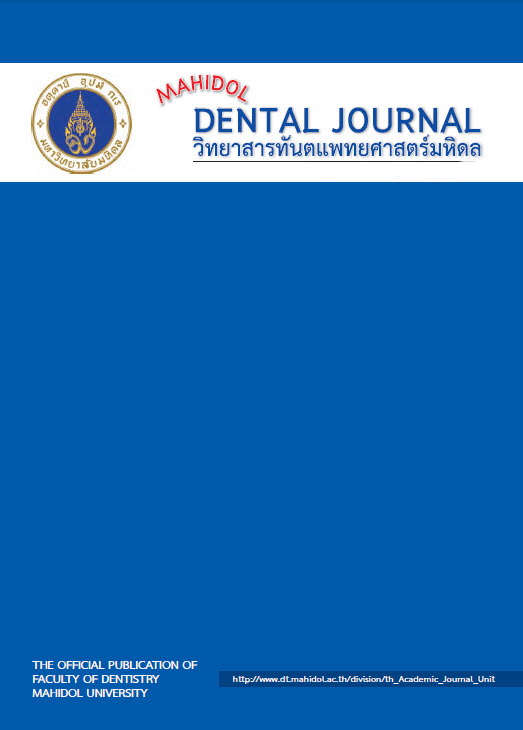Effect of Schizophyllan on Proliferation and Migration of Human Gingival Fibroblast
Main Article Content
Abstract
Objective: The purpose of this study was to investigate the effect of schizophyllan on cytotoxicity proliferation and migration of human gingival fibroblast (HGF).
Materials and Methods: For cytotoxicity assay : HGF were plated in 96 well-plate with 2×104 cells/ml and cultured in DMEM solution containing 10% FBS and antibiotics/antimycotics; treated with schizophyllan at final concentration 0.1, 0.5, 1.0, 5.0 and 10.0 mg/ml and incubated for 24 hours in CO2 incubator at 5% CO2, 100% humidity. Cell viability was evaluated using MTT assay.
For cell proliferation assay : HGF were inoculated in 96-well plate with 1×105 cells/ml for 24 h. Afterward schizophyllan at final concentration of 0.1, 0.5, 1.0, 5.0 and 10.0 mg/ml were added and cultured for 13 days under same condition as described above. The media were routinely changed every 2 days. Numbers of viable cells were determined using MTT assay.
For cell migration assay : HGF at concentration of 1×105 cells/well were seeded into for 24 well plate and grown for 24 hours in DMEM containing 10% FBS and antibiotics/antimycotics. Cell were scratched by using 1,000 ul steriled pipette tip. The schizophyllan (0.1, 0.5, 1.0, 5.0 and 10.0 mg/ml) was added and further incubated under same condition for 24 hours. After 24 hours cells were stained with toluidine blue O and left dried overnight. The migrated cells were counted by using Image Pro Plus program (version 7).
Result: The result suggested that shizophyllan had no toxicity in all concentrations tested. The cell proliferation assay showed that when cells were treated with 10.0 mg/ml schizophyllan, the amount of cell proliferation was 5.7×104 cell/well which is higher than control (5.0×104 cell/well). There were significant differences when comparing the amount of cell proliferation between schizophyllan at the concentration of 10 mg/ml with the control. The cell migration assay showed that schizophyllan at 5.0 and 10.0 mg/ml can promote the migration of cells into wounded area. The mean of migrated cell was 167, 204 cells/Sq mm respectively. There were significant differences in the mean of migrated cells between the concentration at 5.0 and 10.0 mg/ml with the control
Conclusion: Schizophyllan up to 10 mg/ml has no cytotoxicity to HGF and can promote cell proliferation. Schizophyllan at 5 and 10 mg/ml can induce the migration of cell into the wounded area. This study may be useful for the development of some drugs to promote wound healing in the oral cavity.
Article Details
References
2. David LW. Overview of (1→3)-β-D-glucan immunobiology, Mediators Inflamm 1997 ; 6: 247-250.
3. Bohn JA, BeMiller JN. (1-3)-Beta-D-glucans as biological response modifiers: a review of structure-functional activity relationships. Carbohydr Polym 1995; 28: 3-14.
4. Enoch S, Leaper DJ. Basic science of wound healing. Surgery 2008; 26: 31-37.
5. Young A, McNaught CE. The physiology of wound healing. Surgery 2011; 29: 475-479.
6. Pereira LP, Mota MRL, Brizeno LAC, Nogueira FC, Ferreira EGM, Pereira MG, et al. Modulator effect of a polysaccharide-rich extract from Caesalpinia ferrea stem barks in rat cutaneous wound healing: role of TNF-α, IL-1β, NO, TGF-β. J Ethnopharmacol 2016; 187: 213-223.
7. He Y, Ye M, Du Z, Wang H, Wu Y, Yang L. Purification, characterization and promoting effect on wound healing of an exopolysaccharide from Lachnum YM405. Carbohydr Polym 2014; 105: 169-176.
8. Berg LMVD, Zijlstra-Willems EM, Richters CD, Ulrich MMW, Geitenbeek TBH. Dectin-1 activation induces proliferation and migration of human keratinocytes enhancing wound re-epithelialization. Cell Immunol 2014; 289: 49-54.
9. Kougias P, Wei D, Rice PJ, Ensley HE, Kalbfleisch J, Williams DL, et al. Normal human fibroblasts express pattern recognition receptors for fungal (1→ 3)-β-D-glucans. Infect Immun 2001; 69: 3933-3938.
10. Zhang Y, Kong H, Fang Y, Nishinari K, Phillips GO. Schizophyllan: A review on its structure, properties, bioactivities and recent developments. Bioact Carbohydr Diet Fibre 1 2013; 1: 53-71.
11. Falch BH, Espevik T, Ryan L, Stokke BT. The cytokine stimulating activity of (1→ 3)-β-D-glucans is dependent on the triple helix conformation. CARBOHYDR RES 2000; 329: 587-596.
12. Son HJ, Han DW, Baek HS, Lim HR, Lee MH, Woo YI, et al. Stimulated TNF-α release in macrophage and enhanced migration of dermal fibroblast by β-glucan. Curr Appl Phys 2007; 7: 33-36.
13. Usui S, Tomono Y, Sakai M, Kiho T, Ukai S. Preparation and Antitumor Activities of BETA-(1→6) Branched (1→3)- BETA-D-Glucan Derivatives. BIOL PHARM BULL 1995; 18: 1630-1636.
14. Wei D, Williams D, Browder W. Activation of AP-1 and SP1 correlates with wound growth factor gene expression in glucan-treated human fibroblasts. Int Immunopharmacol. 2002; 2: 1163-1172.
15. Son HJ, Bae HC, Kim HJ, Lee DH, Han DW, Park JC. Effects of β-glucan on proliferation and migration of fibroblasts. Curr Appl Phys 2005; 5: 468-471.
16. Zhong K, Tong L, Liu L, Zhou X, Liu X, Zhang Q, et al. Immunoregulatory and antitumor activity of schizophyllan under ultrasonic treatment. Int J Biol Macromol. 2015; 80: 302-308.
17. Hirata A, Itoh W, Tabata K, Kojima T, Itoyama S, & Sugawara, I. Anticoagulant activity of sulfated schizophyllan. BBB 1994; 58: 406-407.


